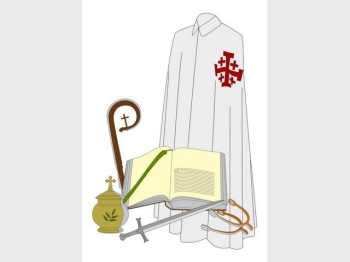The use of the sword in the investiture ceremonies of the Order of the Holy Sepulchre

A few days ago - more precisely on 7 May 2021 - the new text of the Order of Rites for the Celebrations of the Order promulgated on March 19, 2021 by the Most Eminent Grand Master, Cardinal Fernando Filoni, was sent to the Members of the Grand Magisterium, to the Lieutenants and to the Magistral Delegates of the entire Equestrian Order of the Holy Sepulchre of Jerusalem. The date of the formal promulgation could not have been more opportunely chosen, considering that - as the relative decree also explicitly states - it is the day on which the Church celebrates the solemnity of Saint Joseph, Patron of the Church. And, in fact, this date takes on an even greater significance in light of this being the Year of Saint Joseph, proclaimed by Pope Francis on 8 December 2020 with the Apostolic Letter Patris corde.
In the promulgation decree, it is stated that I was specifically asked to express my opinion in my capacity as Lieutenant General, thus I feel it is my duty to share my reflections with the friends of the Order.
The reader will allow me a personal notation. The first time I attended an investiture of the Order, over 25 years ago, I was disconcerted to see on the altar, a bishop, dressed in episcopal liturgical vestments, who, during the celebration of the Mass (infra missam), wielded - in this specific case, awkwardly - a sword, that is, a weapon. As a historian it was clear to me that, in the Middle Ages, the investiture of a new knight involved the use of the sword, but the one who used it was a layman, himself already invested. This anomaly led me, even as a university professor of Church history, to further investigation of the subject.
I will try to briefly explain my thoughts in 4 points.
1. There is no evidence that the Order was founded for the First Crusade, which is why any reference to the Crusades and Godfrey of Bouillon, in particular, is anachronistic.
2. We know from multiple sources that investiture as a knight of the Holy Sepulchre began to be conferred, not before the first decades of the fourteenth century, by lay nobles on others similar to them during a common pilgrimage to Jerusalem. The role of the Franciscans of the Custody of the Holy Land was limited to preparing the basilica of the Holy Sepulchre in view of the ceremony and celebrating the Mass at the end of which the investiture took place.
3. From the end of the 15th century, and precisely from 1496 onwards, the right to invest the new knights was conferred on the Franciscan Custos of the Holy Land. As for the ritual of the ceremony, the first text that has come down to us dates back to 1623. It appears that the ceremony was centred on the delivery of the sword to the candidate, who, on having unsheathed it from the scabbard, handed it to the celebrant. The latter, tracing the sign of the cross in the air three times with it, touched the candidate's shoulders with his weapon. At the end of the rite, the new knight returned the sword to the Custos, as the specimen used was the sword that belonged to Godfrey of Bouillon (or preserved as such).
4. The decision, taken by Leo XIII in 1888, to also admit ladies to the Order has, in fact, caused an irreversible break in continuity. The entry of Dame into an institution which, by its nature, was open to men only, resulted in the abandonment of its original identity of the chivalric order, in the sense in which this expression was understood in the Middle Ages. From this new reality the need arose to admit Dames with a different formula to the one used for men, and without resorting to the use of the sword.
At the beginning of the 21st century, it no longer seems acceptable that people bound by the same obligations and holders of the same rights are received in different ways in the same institution. The new ritual fully responds to this elementary need. It should also be noted that the sword, due to the symbolic meaning it has, is however foreseen in the liturgy of the Vigil. Finally, please allow someone who in 25 years of militancy has witnessed a hundred investitures across five continents, often significantly different from each other, to applaud the prospect that from now on, the celebration of the most solemn act foreseen by the liturgy of the Order, is identical, in words and gestures, in all the Lieutenancies and Magistral Delegations of the Equestrian Order of the Holy Sepulchre of Jerusalem.
Agostino Borromeo
Lieutenant General
(May 12, 2021)



